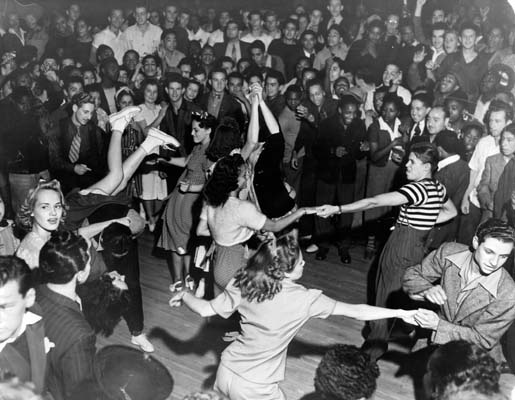
Jitterbug dancers, 1939. Photo courtesy of George Spink.
In 1936 young people across the country jitterbugged to the sounds of the ‘King of Swing’ Benny Goodman and His Orchestra. Benny was a square-looking guy with his wire-rimmed glasses, starched white shirt and banker’s tie but he played the hottest of hot jazz on his clarinet. Goodman became one of the first megastars in American pop music to ride the wave of fame on a youth audience.
New technology in the form of network radio played a huge part in launching the original Swing craze in 1935, and one radio show—NBC’s Let’s Dance—made all the difference. Jazz history pinpoints August 1, 1935 and a Benny Goodman concert at the Palomar Ballroom, as the moment in time and the spot on the map where the Benny Goodman Orchestra and Swing music reached critical mass, making it over the top as an ‘overnight’ success. In reality, it took both Goodman and Swing music a long, hard pull to get that breakthrough.
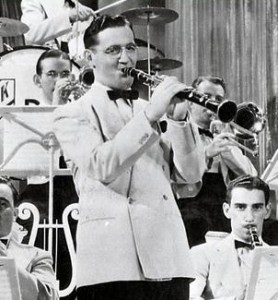
Benny Goodman. Photo courtesy of drummerworld.
Benny Goodman’s first real opportunity in show business came in 1934 when NBC offered him a slot with three other dance bands on a five-hour Saturday late-night network radio series out of New York called Let’s Dance. The concept driving the broadcast series was the introduction of a new Ritz ‘party cracker’ manufactured by the National Biscuit Company. The show included a sweet band, a Latin band and a hot band. Goodman’s orchestra fell into the ‘hot band’ slot in the final hour of the live broadcast. The network executives making the decision thought Goodman’s fresh, new sound would attract teens and twenty-somethings long after the older audience had tuned out and gone to bed.
In spite being a featured act with a weekly spot on the Let’s Dance national broadcast series, Benny Goodman had a tough time keeping his band together. The economy was stalled in the middle of the Great Depression, and Goodman’s nationwide tour in 1935 was not the success everyone had hoped for. The Goodman Orchestra limped across the country playing for half-empty houses and to lukewarm response.
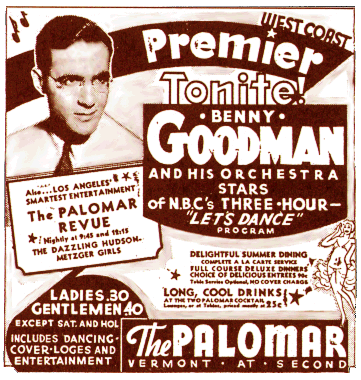
Poster image courtesy of songbook1.wordpress.
By the time the Goodman Orchestra reached California for their gig at the Palomar Ballroom near Los Angeles, they were about ready to pack it in. To the surprise of Goodman and his disheartened musicians, the Palomar was packed with fans, who had heard their music on the national broadcast of Let’s Dance. Little did anyone realize what an impact the three-hour time change would make with listening audiences between the east and west coasts. It would be midnight in New York when the Goodman Orchestra came on the show, but it was still prime time in Los Angeles when they hit the airwaves with their hot jazz. Unbeknownst to the Band and the NBC executives, a large and loyal following listened to Goodman’s late-night segment of Let’s Dance out west. The youthful audience at the Palomar jitterbugged the night away on August 31, 1935, the date in jazz history now widely recognized as the moment the nation caught Swing Fever.
On this edition of Riverwalk Jazz, vibes player John Cocuzzi joins The Jim Cullum Jazz Band to play two classic hot tunes recalling the Goodman Quartet sound.
“Sweet Leilani“ started out as a 1937 Academy Award-winner from the movie Waikiki Wedding. Benny Goodman made it his own with his 1937 recording featuring Harry James on trumpet, Jess Stacy on piano and Gene Krupa on drums.
“Stompin' at the Savoy,“ originally composed by Edgar Sampson for the Chick Webb Orchestra in 1934, refers to the legendary Harlem nightspot, the Savoy Ballroom, advertised as the “Home of Happy Feet,” where Webb and his men held forth. Goodman’s cover of the tune was a huge hit.
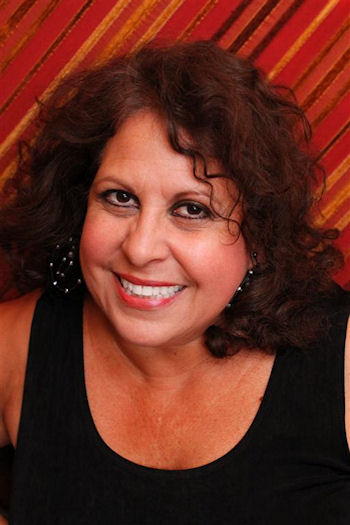
Stephanie Nakasian. Photo courtesy of the artist.
Jazz singer and Riverwalk Jazz favorite Stephanie Nakasian had a highly successful career as an international banker and futures consultant to the New York Stock Exchange before she devoted herself to music. She’s since performed at jazz festivals around the world and at the Kennedy Center, Wolf Trap and Radio City Music Hall.
On this broadcast, Nakasian interprets two Swing Era classics.
“Seems Like Old Times“ was the theme song for Arthur Godfrey’s long-running radio show and was memorably revived by Diane Keaton in Woody Allen’s Annie Hall.
The Benny Goodman Orchestra’s 1936 recording of “Goody, Goody“ with lyrics by Johnny Mercer held the number one spot on the popular radio series Your Hit Parade for four weeks.
Riverwalk Jazz guest Lionel Hampton, heard on this broadcast, was an integral participant in Swing history as a star member of Benny Goodman’s small ensembles. On this broadcast, Hampton reprises “Avalon” with the Cullum Band rhythm section, a 1937 hit first recorded with Benny Goodman.
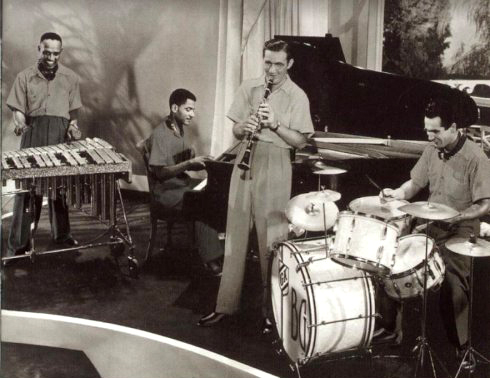
Benny Goodman Quartet, 1938. Photo courtesy of lionelhampton.nl.
California trombonist Dan Barrett joins The Jim Cullum Jazz Band for “Feeling High and Happy,“ a tune written in 1938 by the team of Rube Bloom and Ted Koehler and recorded by Goodman’s ensemble.
George and Ira Gershwin composed “Oh, Lady Be Good“ in 1924 for a Broadway show of the same name starring Fred and Adele Astaire. Later it became a frequently recorded standard of the Swing Era.
Fronting his own band, Louis Armstrong helped usher in the Swing Era. Jim Cullum says, “In the 30s Armstrong entered the second phase of his multi-faceted career. His bubbling, magical personality was fully developed, and his clear, swinging upper register trumpet playing was different from the earlier Louis, but just as great. With this combination of skill and talent, Armstrong single-handedly inspired the Swing Era. All the big band brass section riffs were mainlined straight from Louis. Though Goodman, Dorsey, Glenn Miller and the Bob Crosby Band got credit, Louis was the real genius behind the music.”
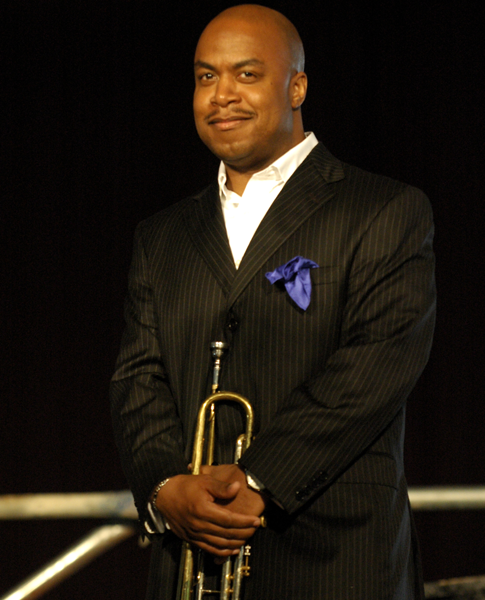
Trumpeter Nicholas Payton. Photo courtesy of the artist.
Louis Armstrong recorded the Arlen/Mercer classic “I Gotta Right to Sing the Blues,“ in 1933 with Teddy Wilson and Jack Teagarden. Our version is performed by trumpet star Nicholas Payton, a New Orleans native considered a “young lion” of jazz at the time of this recording. Payton also joins Jim and the Band for “Swing That Music,“ originally recorded by Louis Armstrong in 1936.
Trumpet and flugelhorn master Clark Terry joins The Jim Cullum Jazz Band on this broadcast with two numbers he recorded and frequently performed during his tenure with the Ellington Orchestra. Duke Ellington’s “Don't Get Around Much Anymore“ and “It Don't Mean a Thing (If It Ain't Got That Swing).”
Stage and film actor and singer Carol Woods recalls Ella Fitzgerald’s breakthrough hit record with Chick Webb from 1938, “A Tisket, A Tasket.“ It held the number one spot on Your Hit Parade for six weeks.
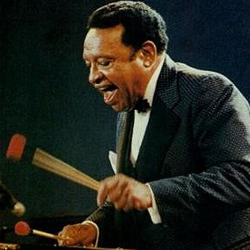
Lionel Hampton. Photo courtesy of jazzprofessional.
Lionel Hampton tells the story of composing one of his most famous tunes, “Flyin' Home,” during his very first airplane ride. He says he was flying from Los Angeles to Atlantic City for a gig with Benny Goodman when he started singing to himself to calm his nerves. Benny turned to him and said, “What’s that you’re humming?” Lionel said, “I don’t know. Just ‘Flyin’ Home,’ I guess.” The tune would become Hamp’s theme song for decades. On this broadcast, Lionel Hampton joins an expanded Jim Cullum Jazz Band for a medley of this original and another Swing Era favorite, Glenn Miller’s “In The Mood.“ This medley arrangement was a staple of the Hampton band’s repertoire.
Photo credit for Home Page:The Savoy marquee courtesy songbook1.wordpress.
Text based on Riverwalk Jazz script by Margaret Moos Pick ©1999

